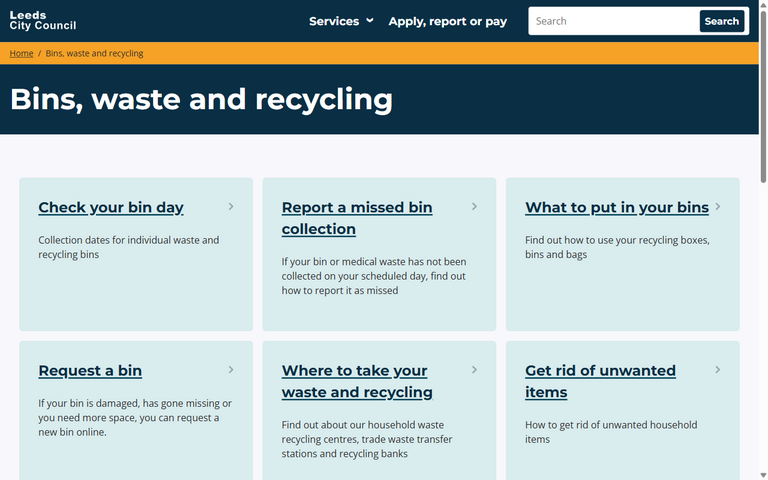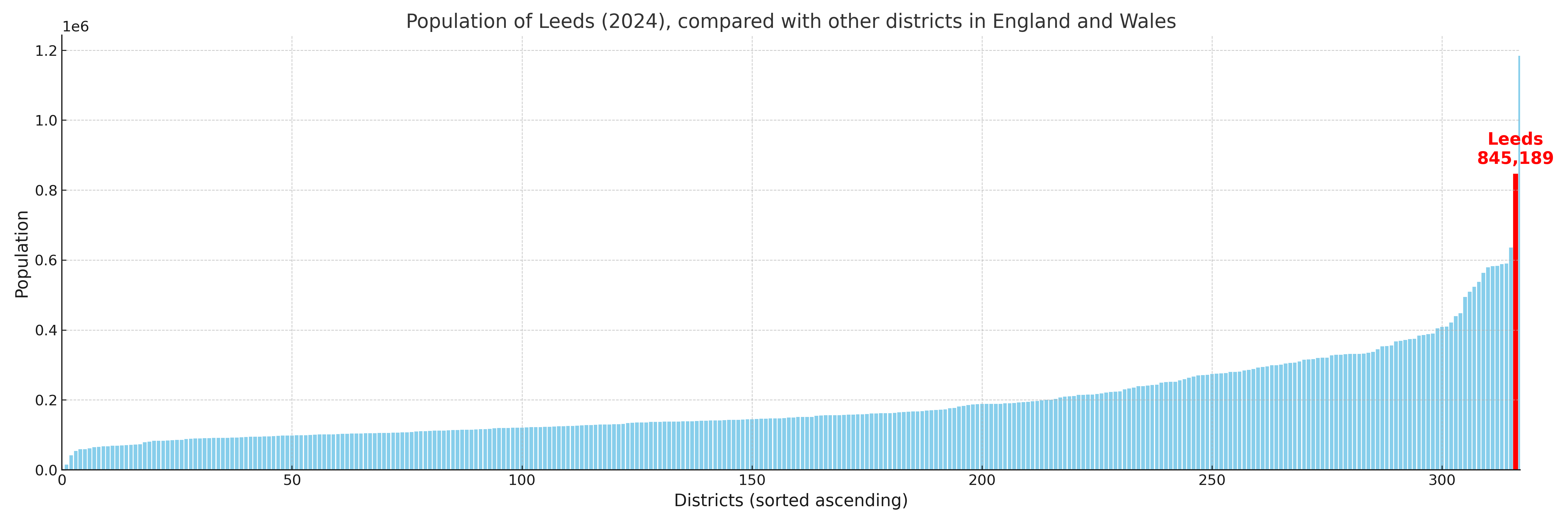Leeds
§ This page gives an overview of the Leeds local authority district, bringing together key facts, maps, and data to help you quickly understand the area. One of 361 district profiles on Baseview.
Overview ⁞ Leeds, the largest city in West Yorkshire, combines a thriving urban centre with extensive suburbs and surrounding countryside. The city centre features striking Victorian arcades, Leeds Town Hall, the Corn Exchange, and modern developments such as Trinity Leeds and Victoria Gate. Cultural venues include Leeds Art Gallery, the Royal Armouries, and Leeds Grand Theatre. The River Aire and Leeds-Liverpool Canal run through the city, with regenerated waterfront areas offering restaurants and leisure. Outlying towns and suburbs such as Horsforth, Morley, and Otley add historic charm, while Roundhay Park and Golden Acre Park provide green escapes. The nearby Wharfe Valley and Yorkshire Dales extend scenic beauty into the district.
Leeds Boundary Map
This map shows the official boundary of the Leeds local authority district, based on the latest geographic data published by the Office for National Statistics (ONS). It provides a clear view of the district’s extent and helps you understand how the area fits within the wider regional and national landscape.
Contains OS data © Crown copyright and database right 2025. Source: Office for National Statistics licensed under the Open Government Licence v3.0.
The administrative boundary of Leeds can also be viewed on OpenStreetMap: District Boundary of Leeds.
Key Facts about Leeds
What region is Leeds in? Leeds is in the Yorkshire and The Humber of England, a region within the UK.
What county is Leeds in? Leeds is located in the county of West Yorkshire.
Is Leeds a city? Yes, Leeds is a city. Leeds holds official city status as one of the 76 designated cities in the UK.
Who governs Leeds? The local government for this district is: Leeds City Council (Metropolitan District).
▶ Official website of Leeds City Council 🔗 leeds.gov.uk

Which police force covers Leeds? Policing in Leeds is provided by West Yorkshire Police 🔗 westyorkshire.police.uk, which serves 5 local authority districts: Bradford ⁞ Calderdale ⁞ Kirklees ⁞ Leeds ⁞ Wakefield.
Leeds in International Geographies
In the International Territorial Levels (ITLs) hierarchy, Leeds is an ITLs Level 3 area:
- (ITL 1) Yorkshire and The Humber
- (ITL 2) ⇒ West Yorkshire
- (ITL 3) ⇒⇒ Leeds
The International Territorial Levels are used by OECD member countries for statistical purposes to classify administrative areas. We have this listable page for easy browsing of ITL names and codes: International Territorial Levels.
Constituencies in Leeds
Leeds is divided into 10 parliamentary constituencies, listed below in alphabetical order.
- Leeds Central and Headingley
- Leeds East
- Leeds North East
- Leeds North West
- Leeds South
- Leeds South West and Morley
- Leeds West and Pudsey
- Selby
- Wakefield and Rothwell
- Wetherby and Easingwold
A constituency is a specific geographical area that elects one Member of Parliament (MP) to represent them in the House of Commons. The United Kingdom is divided into 650 parliamentary constituencies, 54 of them are in Yorkshire and the Humber region. We have this list page for easy browsing of all UK parliamentary constituencies: List of Constituencies.
Wards in Leeds
Leeds is divided into 33 wards, listed below in alphabetical order.
- Adel & Wharfedale
- Alwoodley
- Ardsley & Robin Hood
- Armley
- Beeston & Holbeck
- Bramley & Stanningley
- Burmantofts & Richmond Hill
- Calverley & Farsley
- Chapel Allerton
- Cross Gates & Whinmoor
- Farnley & Wortley
- Garforth & Swillington
- Gipton & Harehills
- Guiseley & Rawdon
- Harewood
- Headingley & Hyde Park
- Horsforth
- Hunslet & Riverside
- Killingbeck & Seacroft
- Kippax & Methley
- Kirkstall
- Little London & Woodhouse
- Middleton Park
- Moortown
- Morley North
- Morley South
- Otley & Yeadon
- Pudsey
- Rothwell
- Roundhay
- Temple Newsam
- Weetwood
- Wetherby
In the UK, a ward is a subdivision of a local authority area, used mainly for electoral and statistical purposes. Defined by the ONS, wards represent the primary unit for local elections, each returning one or more councillors to the local council. Wards are also used as a key geography for presenting population and census data.
Parishes in Leeds
Leeds is part-parished: 37 civil parishes (listed A-Z below) alongside 11 unparished areas.
- Aberford
- Allerton Bywater
- Alwoodley
- Arthington
- Austhorpe
- Bardsey cum Rigton
- Barwick in Elmet and Scholes
- Boston Spa
- Bramham cum Oglethorpe
- Bramhope
- Carlton
- Clifford
- Collingham
- Drighlington
- East Keswick
- Gildersome
- Great and Little Preston
- Harewood
- Horsforth
- Kippax
- Ledsham
- Lotherton cum Aberford
- Micklefield
- Morley
- Otley
- Parlington
- Pool
- Rawdon
- Scarcroft
- Shadwell
- Sturton Grange
- Swillington
- Thorner
- Thorp Arch
- Walton
- Wetherby
- Wothersome
A civil parish is the lowest tier of local government in England, used for villages, small towns, and suburbs. They have their own local authority, either a parish council or a parish meeting, which provides local services like managing parks, allotments, and streetlights, and represents the community's views to larger councils.
Built-up Areas in Leeds
Leeds covers 46 built-up areas, listed below in alphabetical order.
- Aberford *
- Allerton Bywater
- Bardsey
- Barwick in Elmet
- Batley *
- Boston Spa
- Bradford *
- Bramham
- Bramhope
- Calverley
- Carlton (Leeds)
- Castleford *
- Collingham (Leeds)
- Dewsbury *
- Drighlington *
- East Ardsley *
- East Keswick
- Garforth
- Gildersome
- Guiseley *
- Harewood
- Kippax
- Kirkhamgate *
- Leeds
- Linton (Leeds)
- Lofthouse and Robin Hood *
- Menston *
- Methley
- Micklefield
- Mickletown
- Morley (Leeds)
- Otley (Leeds) *
- Pool-in-Wharfedale *
- Pudsey *
- Rawdon *
- Rothwell (Leeds)
- Scarcroft
- Scholes (Leeds)
- Shadwell
- Swillington
- Thorner
- Thorp Arch
- Thorpe on the Hill (Leeds)
- Wakefield *
- Wetherby *
- Yeadon *
In the UK, a Built-up Area (BUA) is a continuous urban area of at least 20 hectares (0.2 km²), defined by the ONS as land where buildings are generally no more than 200 metres apart, such as towns, cities, or large villages. (Note: A BUA name marked with an asterisk (*) indicates that the area is situated partly in the district of Leeds.)
Leeds compared with other districts in the UK
This section shows how Leeds compares with other local authority districts in the UK, using a variety of measures and rankings.
Leeds has 33 electoral wards.

Leeds has a population of 845,189 (2024 mid-year estimate by ONS)

More local statistics and data for Leeds can be found on the ONS statistics for Leeds.